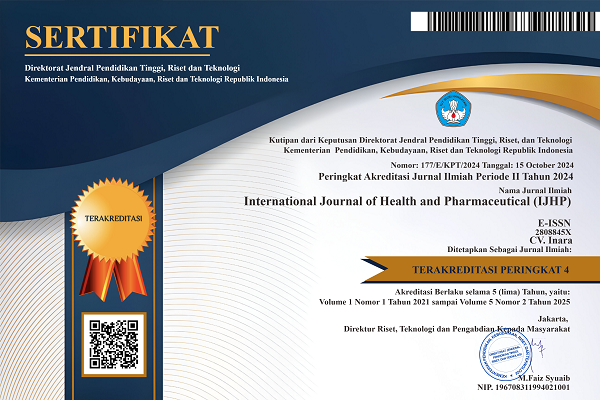The Influence Of Mozaic Techniques On Development Fine Motor In Children Aged 3-4 Years In Early Childhood Education Programs (ECEP) Family Planning (FP) Pancasila Serang Banten July Period 2022
DOI:
https://doi.org/10.51601/ijhp.v3i4.243Abstract
Background: The high number of children who have fine motor skills that are not appropriate for their age is 38.9%
in PAUD KB Pancasila because there are still many parents who do not understand fine motor skills that are
appropriate for their child's age and also they do not stimulate their children's abilities. The first five years of
growth are usually called the golden age, the window of opportunity, and the critical period. Children aged 0-5
years, the development of intelligence increases by about 50% and in children aged 6-8 years it increases by up to
80%. Objective: To find out the effect of mosaic technique on fine motor development of preschool children 3-4
years old at PAUD Ciomas, Serang Regency, Banten, for the period of July 2022. Methodology: The research
design used was quasi-experimental with one group pretest and posttest design. The population in this study were
children aged 3-4 years who attended PAUD Ciomas totaling 126 respondents. This research will be conducted in
PAUD Ciomas Serang. The time of the research will be carried out in July 2022. Result of research: It is known that
the average result of fine motor development of children aged 3-4 years before being given the mosaic technique is
5.4. The average result of fine motor development of children aged 3-4 years after being given the mosaic technique
is 9.5. There was an increase in the fine motor development of children aged 3-4 years after being given the mosaic
technique as much as 3.9. Conclusion: Based on the different test results of fine motor development of children aged
3-4 years before and after doing the mosaic technique, a significant value was obtained 0.000 <0.05, meaning that
there were changes in the fine motor development of children aged 3-4 years before and after doing the mosaic
technique. Suggestion: It is hoped that all health workers will provide more counseling about the development and
growth of children according to their age. And it is hoped that routinely in holding posyandu.
Downloads
References
Arifah. (2014). Developing Fine Motor Skills Through Mosaic Techniques in Group A Children at ABA
Kindergarten Khadijah Bangunjiwo Timur Kasihan Bantul [Online].
Arifin, Z. (2011). Educational Research (New Methods and Paradigm). Bandung: PT. Remaja Rosdakarya.
Arikunto, Suharsimi. (2010). Research Procedures A Practice Approach. Yogyakarta: Rineka Cipta.
Absari, Y. 2017. Factors Influencing Perineal Rupture Incidence in Normal Childbirth at BPM Wayan Witri
Sleman Yogyakarta.
Anonymous. Betel Leaf Extract Gel Preparation. Pharmacy Magazine [online]. 2006.164 [accessed December
, 2022]. Downloaded at: ml.scribd.com/doc/ 168 805358/gel-sirih, 2006.
Arikunto, 2010. Research Procedures A Practice Approach. Jakarta: Nrineka.
Bago E. Benefits and Efficacy of Betel Leaf [online]. 2011 [accessed December 15, 2022]. Downloaded in:
coconian.com. Coconias Blog Host.
Christiana. A, Mizam, Ari Kurniyanti. 2015. The Effectiveness of Betel Leaf Decoction in Accelerating Perineal
Wound Healing. Persada Health Scientific Journal.
Dai Doni, S., Kuswanti, I., and Novitasari, R. 2016. Relationship of Birth Weight with Degrees of Perineal
Rupture in Normal Labor. Journal of Nursing Intan Husada, 3(2), 56.
Gosh. (2010). Self Development for Mentally Disabled Children. Bandung: CV Catur Karya Mandiri.
Barbara. (1978). Teaching Mentally Handicapped Children a hand book of practical activities. London: The
Whitefriars Press Ltd. Delaney, T (2010). 101 Kids Games and Activities. Yogyakarta: Ministry of National
Education
Gallahue and John C. Ozmun. (1998). Understanding Motor Development. Singapore: McGraw-Hill Book CoSingapore. Gluck, Samantha.(2014). E-journal. [On line]. Accessed from
Dwi Giarti Safarini, 2018. The Application of Mosaic Media in Improving the Skills of Wearing Button Clothes
in Moderately Mentally Disabled Children. Indonesian Education University | repository.upi.edu | library.upi.edu
Hurlock, E. (2009). Child Development Sixth Edition Volume 1. Singapore:Mc Graw Hill.
Indraswari, L. (2016). Education journal. [On line]. Accessed from http://ejournal.unp.ac.id.
Ministry of Education and Culture. (2014).Guidelines for Self-Development for Mentally Disabled Students.
Jakarta: Ministry of Education and Culture.
Mahendra, A. and Amung Ma'mun.(1998).Learning Theory and Motor Learning. Bandung: IKIP Bandung Press.
Makmuna. (2015). Clothing Concepts and Semantic Theory. [On line]. Accessed from http://repo.iaintulungagung.ac.id/3229/2/BAB%20II.pdf.
Oswalt, A. (2008).Early Childhood Physical Development. [Online]. Accessed from
Rochyadi, E. (2005). Development of Individual Learning Programs for Mentally Disabled Children. Jakarta:
Ministry of National Education, Directorate General of Higher Education, Directorate of Educational
Development for Higher Education Personnel and Employment.
Smith, B.M., etc. (2002). Mentally Retarded. Ohio: Merrill Prentice Hall.
Somantri, S. (2012). Extraordinary Child Psychology. Bandung: Refika Aditama.
Downloads
Published
Issue
Section
License
Copyright (c) 2023 Fitri Afrilyani, Maryati Sutarno

This work is licensed under a Creative Commons Attribution-NonCommercial 4.0 International License.























